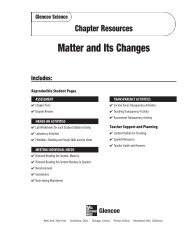Chapter 17: Invertebrate Animals
Chapter 17: Invertebrate Animals
Chapter 17: Invertebrate Animals
You also want an ePaper? Increase the reach of your titles
YUMPU automatically turns print PDFs into web optimized ePapers that Google loves.
Figure 3 This diagram shows<br />
the relationships among different<br />
groups in the animal kingdom.<br />
Estimate the percentage of<br />
animals that are vertebrates.<br />
Animal Classification<br />
Deciding whether an organism is an animal is only the first<br />
step in classifying it. Scientists place all animals into smaller,<br />
related groups. They can begin by separating animals into two<br />
distinct groups—vertebrates and invertebrates. Vertebrates<br />
(VUR tuh bruts) are animals that have a backbone. <strong>Invertebrate</strong>s<br />
(ihn VUR tuh bruts) are animals that do not have a backbone.<br />
About 97 percent of all animals are invertebrates.<br />
Scientists classify the invertebrates into smaller groups, as<br />
shown in Figure 3. The animals within each group share similar<br />
characteristics. These characteristics indicate that the animals<br />
within the group may have had a common ancestor.<br />
Animal Kingdom<br />
<strong>Invertebrate</strong>s<br />
Vertebrates<br />
Cnidarians Roundworms Annelids Echinoderms<br />
Chordates<br />
Sponges Flatworms Mollusks Arthropods<br />
Summary<br />
Animal<br />
•<br />
Characteristics<br />
<strong>Animals</strong> are made up of many different kinds<br />
•<br />
of cells.<br />
Most animal cells have a nucleus and<br />
organelles.<br />
<strong>Animals</strong> cannot make their own food.<br />
•<br />
<strong>Animals</strong> digest their food.<br />
Most animals can move from place to place.<br />
•<br />
Animal Classification<br />
Scientists place all animals into smaller,<br />
•<br />
related groups.<br />
Two distinct groups of animals are the invertebrates<br />
and vertebrates.<br />
Self Check<br />
1. Compare and contrast invertebrate and vertebrate<br />
animals.<br />
2. Describe the different types of symmetry. Name an<br />
animal that has bilateral symmetry.<br />
3. Think Critically Most animals do not have a backbone.<br />
They are called invertebrates. What are some advantages<br />
that invertebrate animals might have over<br />
vertebrate animals<br />
4. Concept Map Using the information in this section,<br />
make a concept map showing the steps a scientist<br />
might use to classify a newly discovered animal.<br />
500 CHAPTER <strong>17</strong> <strong>Invertebrate</strong> <strong>Animals</strong><br />
red.msscience.com/self_check_quiz














